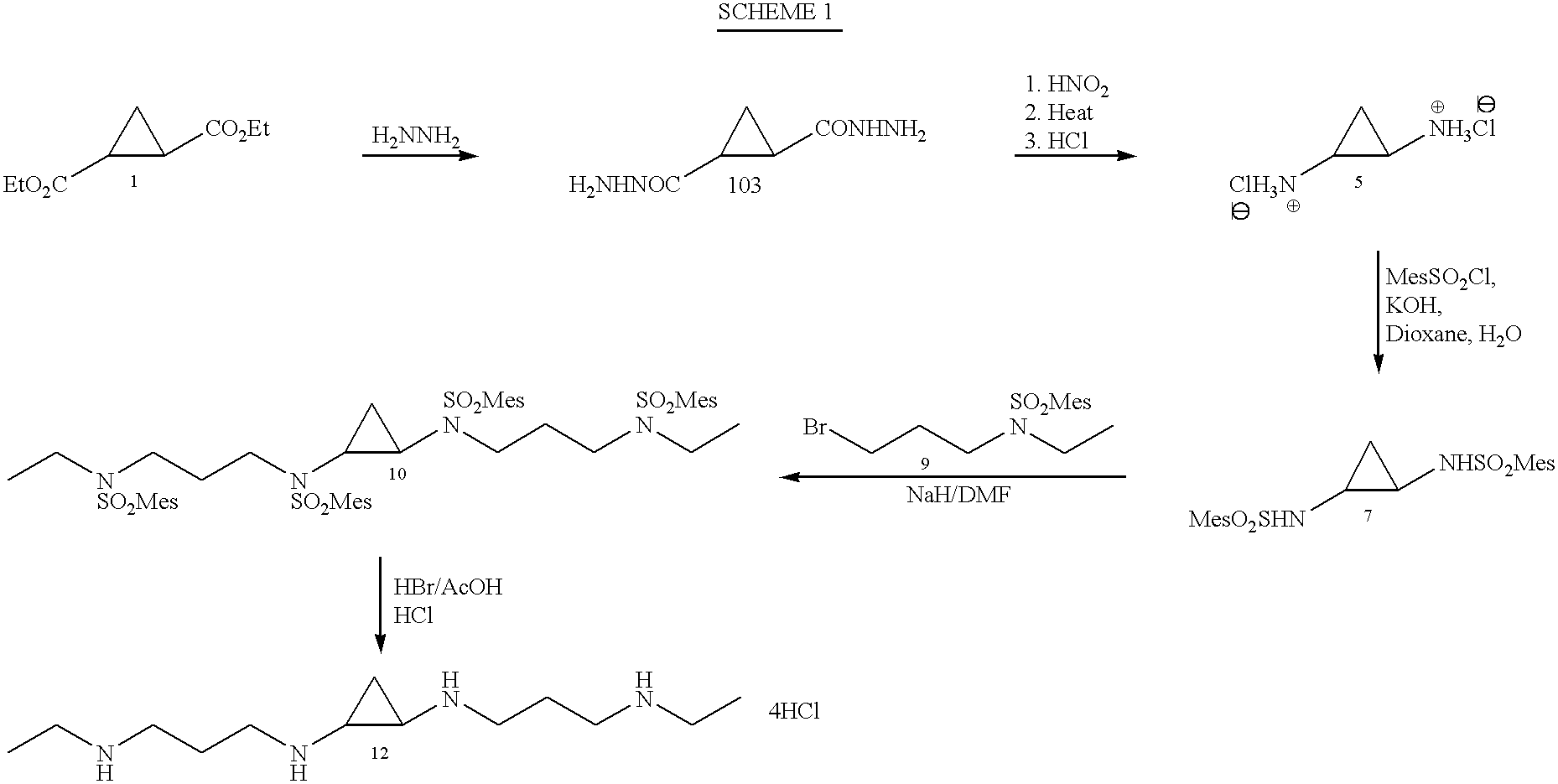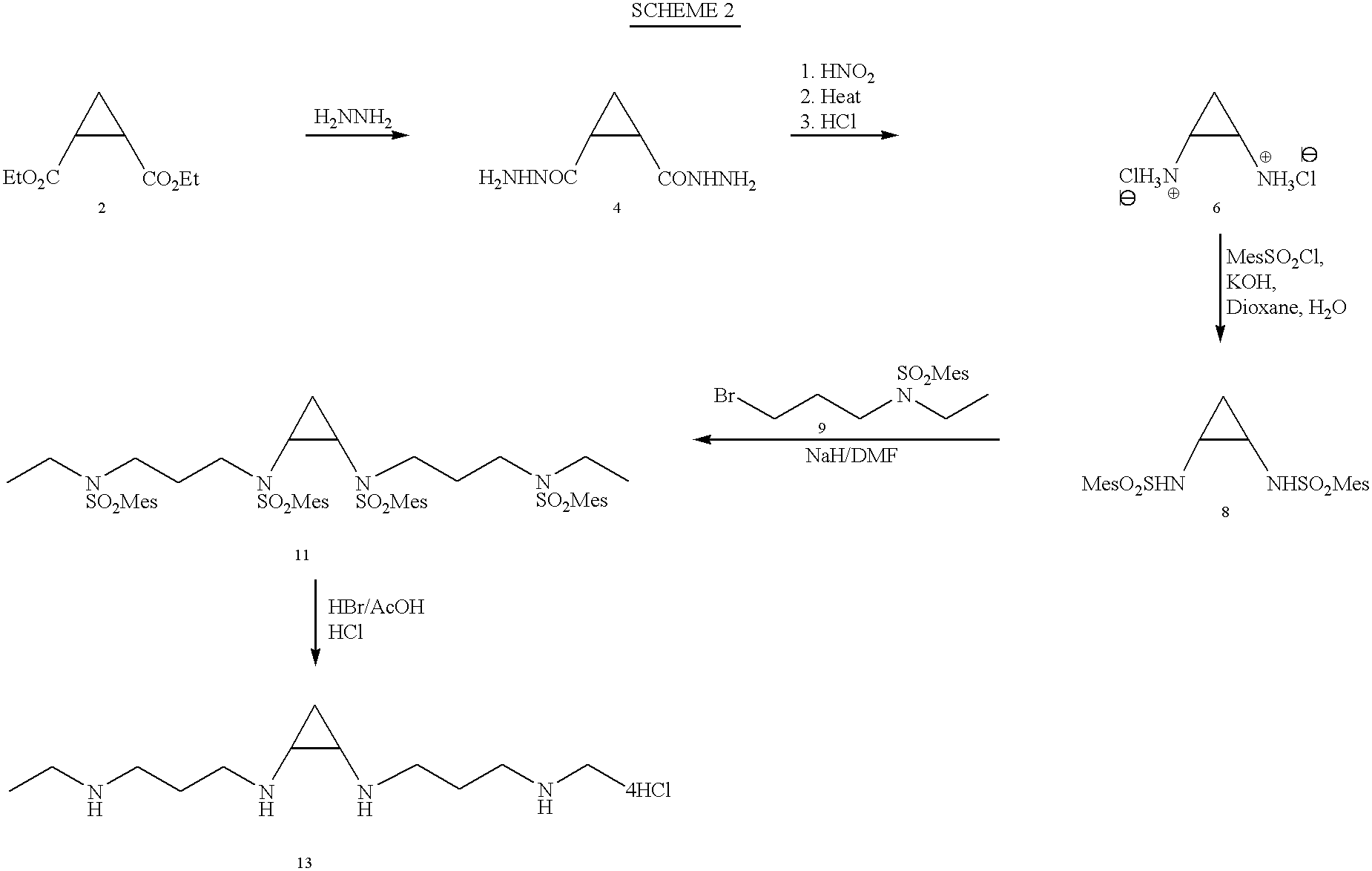Conformationally restricted polyamines
a polyamine and conformationally restricted technology, applied in the field of conformationally restricted polyamines, can solve the problems of a very limited number of 3-dimensional shapes, therapuetic success of dfmo is, however, significantly marred, and the prior art is silent regarding biologically active polyamines
- Summary
- Abstract
- Description
- Claims
- Application Information
AI Technical Summary
Benefits of technology
Problems solved by technology
Method used
Image
Examples
synthesis examples
Chemical Synthesis Examples
The following Examples are an illustrative, not exclusive, listing of the manufacture of several compounds according to the present invention. The Examples are included herein solely to aid in a more complete understanding of the present invention. The Examples do not limit the invention disclosed and claimed herein in any fashion. Reference numerals are to the Reaction Schemes described above.
All melting points are uncorrected. NMR spectra were recorded on 300 MHz spectrometer with TMS as internal standard. Purification of the products was carried out using silica gel 60 (230-400 mesh) and the appropriate solvent system. HPLCs were run on a Waters 8.times.10 "NOVAPAK" cartridge (Millipore Corporation, Marlboro, Mass.) using reverse phase and a gradient of acetonitrile and sodium acetate buffer, pH 4.5.
Compounds 1 and 2 were prepared according to the method of Ashton et al. (1988).
Compound 1: .sup.1 HNMR (CDCl.sub.3): .delta.1.26 (t, J=7 Hz, 6H, CH.sub.2 C...
examples 1-8
A standardized protocol was used to evaluate these test cultures and to generate the data shown in FIGS. 1-8:
Day 1:
Ten standard culture flasks for each drug to be tested were plated with 5.times.10.sup.5 cells of a given type in 5 mL of media and allowed to incubate for 16-24 hours at 37.degree. C.
Day 2:
Fresh stocks of the compounds to be evaluated are prepared. For each drug, two of the ten culture flasks prepared on Day 1 are used as controls. The control flasks are treated with solvent only. Four flasks for each compound are then treated with serially-diluted concentrations of the compound. The remaining flasks are left untouched. The cells are incubated for 4 hours at 37.degree. C.
After 4' hours the control flasks are counted (2 counts for each flask) and the cells per mL calculated based on the average of the control counts. The cells are then re-plated into six 60 mm dishes for each flask from dilutions based on the cells / mL of the control. (In the various test runs, cell conc...
example 1
In vitro effect of SL-11048 (Compound 57) on MCF7
Following the standard protocol described above, the effect of SL-11048 (Compound 57) on MCF7 cell lines was evaluated. The results are depicted in FIG. 1. As shown in FIG. 1, ED.sub.50 =1.49 .mu.M.
PUM
| Property | Measurement | Unit |
|---|---|---|
| temperature | aaaaa | aaaaa |
| temperature | aaaaa | aaaaa |
| temperature | aaaaa | aaaaa |
Abstract
Description
Claims
Application Information
 Login to View More
Login to View More - R&D
- Intellectual Property
- Life Sciences
- Materials
- Tech Scout
- Unparalleled Data Quality
- Higher Quality Content
- 60% Fewer Hallucinations
Browse by: Latest US Patents, China's latest patents, Technical Efficacy Thesaurus, Application Domain, Technology Topic, Popular Technical Reports.
© 2025 PatSnap. All rights reserved.Legal|Privacy policy|Modern Slavery Act Transparency Statement|Sitemap|About US| Contact US: help@patsnap.com



